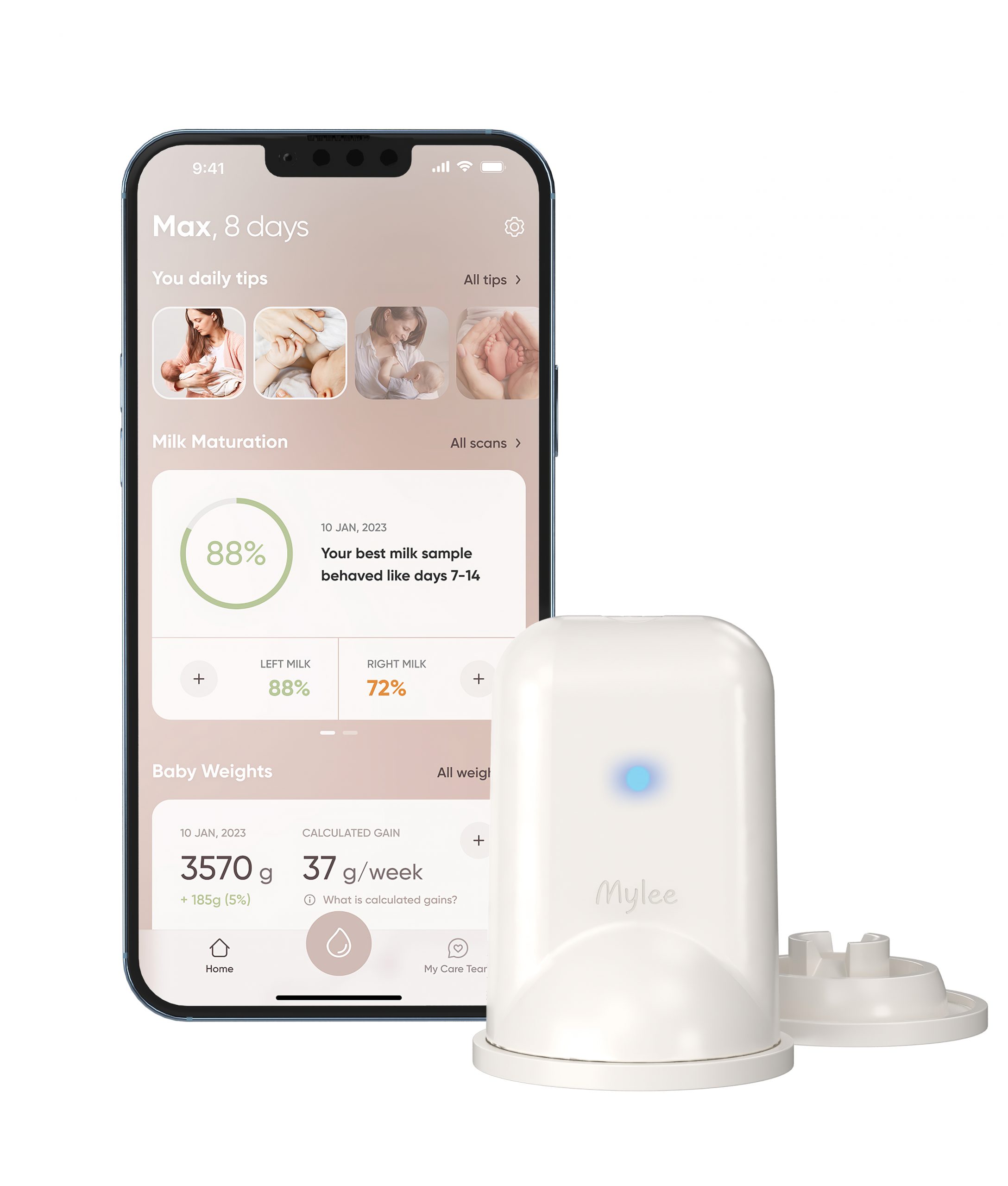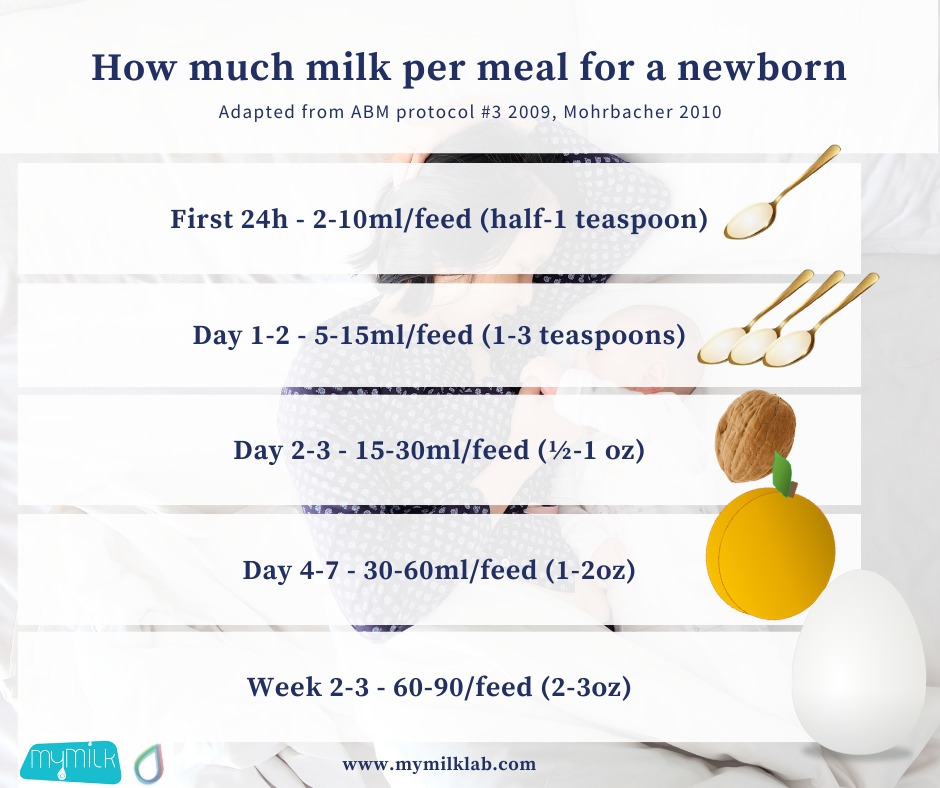

By inserting just several milk drops into the device daily, and app interaction, you can see your day-to-day progress and get personal tips.
The MyLee is in beta testing. You can join!
In the first weeks of breastfeeding, milk is produced in the mother’s breast through a demand and supply mechanism, so that the mother develops the breast infrastructure for milk production and produces milk in accordance with the latch and milk transfer stimulus. But this does not happen over-night, it is a process. Getting breastfeeding established takes a ‘time investment’ and the first days-weeks can be challenging.
The more you breastfeed, and the more effective breastfeeding is, the more milk is produced. Scheduling feeds, use of formula supplements, pacifiers use and other factors that reduce the time the baby spends feeding at the breast may inhibit milk production
Wambach & Riordan, 2016
In the first days, your breasts produce colostrum. Its amount in each meal is small – a few milliliters, , depending on the baby’s stomach. Around the third day after birth (72 hours) the milk undergoes a visual change from colostrum to transitional milk which is whiter, indicating the maturation of the breast tissue for ample milk production (the professional name of the process is Lactogenesis II). The transition from colostrum to transitional milk is accompanied by an increase in the amount of milk, from a volume of less than 100 ml per day to an average of 400-600 ml per day on the fourth day of birth. The “milk come in.” This synchronized process is a critical stage in the normal progress of breastfeeding, which indicates the maturation of the breast to produce increasing milk volume in line with increasing needs of the breastfed baby and reaching a stable daily volume at around 3 weeks after birth. The dynamics of this process is greatly affected by the baby’s suckling efficiency and the frequency of breast emptying. The more you breastfeed and the more milk is excreted from the breast, you will notice how the milk volumes increases, and the color of the milk becomes gradually more bluish-white.

Don’t let those hospital baby bottles confuse you, a newborn stomach size is tiny. In the first day every meal will be literally few drops of colostrum. By day 2 every meal is about 1-3 teaspoons of colostrum. By day 3 every meal is about the size of a walnut. On days 4-7 milk volumes per meal increase up to 30-60ml / 1-2oz. This is still about 1/3-2/3 the size of a full preemie bottle that are sometimes found at the hospital. This jump between day 3 to day 4-5 is sometimes intimidating, but feeding efficiently or hand expressing/pumping regularly within the first 1-3 days, signals to the moms body to make this jump. Remember, if you feed your baby less per feed but give her more feeds per day, this will sum up to a larger daily amount. Worried? -Have a certified lactation consultant observe your latch and feed efficiency -Breastfeed a lot. Beyond the minimum 8 feeds per 24h, and even 10-12-14 times per day especially on days 2-5. -Hand express after/between feeds. If collected, these additional drops can be given to the baby with a clean teaspoon.
In case breastfeeding is not progressing properly, either breastfeeding is not efficient, or there are latch problems, insufficient breastfeeding frequency, adding of formula, if the baby is sleepy, or the baby has problems with suckling that is related to tongue-tie for example, or in special medical circumstances (such as very difficult birth, cesarean birth, excessive blood loss, Certain diseases, gestational diabetes, thyroid imbalance etc.), There may be some delay in the process of milk maturation. A certain delay in the entry of milk per se is not necessarily problematic but it is linked to a certain increase in the risk of increased weight loss of the baby, reduced milk production and breastfeeding problems over time. In such a case, it is of great importance to be proactive in ‘bringing the milk in’, to verify the frequency and effectiveness of breastfeeding, and to contact a professional breastfeeding professional as soon as possible, in order to correct the breastfeeding and monitor the baby’s nutritional status. Correcting breastfeeding as early as possible, alongside frequent stimulation of the breast and emptying (by the baby, by hand expression, and by pumping when needed) will help increase your milk production capacity for the short and also longer term and will increase the chance of successful breastfeeding over time. At this stage of breastfeeding establishment, every day is significant.
Frequency. The baby breastfeeds at least 8 times a day when you offer him to breastfeed at least 10 times a day. Even 12 or more breastfeeds are normal, and it is important to let the baby nurse as many times as she want. In the case of 12 or more breastfeeds a day, when the baby does not appear to be satisfied at the end of breastfeeding, consult a breastfeeding consultant, who will make sure that the latch is good and breastfeeding is effective and progressing as expected. If the baby is sleepy, it is extra important to make sure she feeds at least 8 times a day.
Before breastfeeding. Your breasts feel full.
After Breastfeeding. At the end of breastfeeding, the baby detaches from the breast on her own and appears relaxed. Your breasts are softer and your nipples look whole and round, without pressure and are painless and uninjured.
Dirty diapers. Your baby has at least three yellowish dirty diapers a day. (Starting from the fourth day)
Wet diapers. Your baby has at least 6 wet diapers a day and no odor of concentrated urine.
Baby appearance. Your baby Is calm most of the day (she may prefer to be held, and not in a cradle, but is calm), shiny and lively skin and responds to stimuli.
Overall the breastfeeding experience is starting to be pleasant.
If one of the sections above does not right, it is recommended that you seek professional breastfeeding assistance.
Frequency. Your baby seems to be breastfeeding “all the time” and breastfeeding does not calm her down.
Milk Coming in. You did not feel the fullness of your breasts until the fifth day after birth.
After breastfeeding. The breast remains full and does not soften after breastfeeding. Your nipples are sore throughout breastfeeding.
Urine. Your baby has less than 6 wet diapers per day and there is a smell of urine from the diaper.
Dirty diapers. If your baby still secretes meconium (the first stool – black and sticky) after she is 5 days old. Or if your baby has less than 3 dirty diapers a day after she is 4 days old.
Appearance of the baby. Your baby is not quiet most of the day or alternatively, if she is apathetic and unresponsive to stimuli. If your baby is very sleepy and has only short effective latches. If her skin looks dry, or overall appearance is poor.
Weight gain. She does not start gaining weight following the 4th day and if she have not returned to her birth weight at two weeks old.

Snapshot from MyMilk breastfeeding guide
Link to educational video by Dr. Jane Morton From Stanford Medicine – HAND EXPRESSION EDUCATIONAL VIDEO
Well Fed Baby Checklist (day 5-7 after birth), From Stanford Medicine